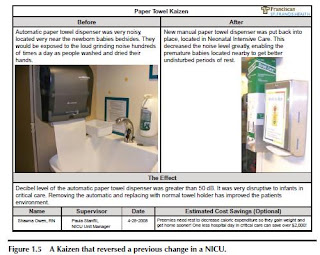If the first chapter is any indication, Healthcare Kaizen, a forthcoming book by Mark Graban and Joseph Swartz, will quickly rise to the "must have" category for people interested in adopting the Lean process improvement philosophy for their organizations. Mark has worked as a consultant and coach to healthcare organizations
throughout North America and Europe. Joseph is the Director of Business
Transformation for Franciscan St. Francis Health of Indianapolis, IN.
This is more than a how-to book. It promises to be replete with examples of success and failure. I found these simple stories to be inspirational, while also exemplifying the underlying premise of Lean: Empowerment of front-line staff.
The authors note: "In this book, we will use the term Kaizen in the context that is often least practiced and least appreciated in healthcare (as well as other industries)—continuous improvements that happen without the formal structure of a large team or a major project.."
"Kaizens tend to be small, local changes at first. In many organizations, the focus of improvement is on innovation or larger scale improvements, or home runs, to use a baseball analogy. . . . A Kaizen organization supplements necessary and large, strategic innovations with lots of small improvement ideas—the equivalent of singles and doubles in baseball. The expectation is that a large number of small changes leads to an impressive impact to an organization’s core measures. Small changes, which can be completed more quickly than major projects, can build enthusiasm and problem-solving skills that people can then apply to larger problems."
Here's one example:
Changing Back Can Be Better for Babies
In early 2008, the Franciscan maintenance department replaced the manual paper towel dispensers in the NICU with hands-free automatic paper towel dispensers. One automated dispenser located near a group of babies made a loud grinding noise each time it dispensed a paper towel and nurses noticed babies flinching when this happened. Occasionally, the noise would wake one of the babies and the nurses knew how important rest was for recovery. Most of Paula Stanfill’s nurses chose a career in the NICU because of their passion and compassion for babies.
After some debate, her nurses suggested they go back to the manual dispensers . Paula wondered if she should let them because it seemed as though they were going backward. Then, her staff measured the decibel level of the automatic paper towel dispenser and found it was greater than 50 decibels. Paula was convinced. She approved having the automatic dispenser removed and replaced with the old manual paper towel holder. It was not as fancy, but it was better for the babies under their care. The babies were happier and healthier, which led to happier staff, which made Paula happy. Their Kaizen Report is shown in Figure 1.5. Paula learned that she needed to listen.
For more information, visit the book's website.
This is more than a how-to book. It promises to be replete with examples of success and failure. I found these simple stories to be inspirational, while also exemplifying the underlying premise of Lean: Empowerment of front-line staff.
The authors note: "In this book, we will use the term Kaizen in the context that is often least practiced and least appreciated in healthcare (as well as other industries)—continuous improvements that happen without the formal structure of a large team or a major project.."
"Kaizens tend to be small, local changes at first. In many organizations, the focus of improvement is on innovation or larger scale improvements, or home runs, to use a baseball analogy. . . . A Kaizen organization supplements necessary and large, strategic innovations with lots of small improvement ideas—the equivalent of singles and doubles in baseball. The expectation is that a large number of small changes leads to an impressive impact to an organization’s core measures. Small changes, which can be completed more quickly than major projects, can build enthusiasm and problem-solving skills that people can then apply to larger problems."
Here's one example:
Changing Back Can Be Better for Babies
In early 2008, the Franciscan maintenance department replaced the manual paper towel dispensers in the NICU with hands-free automatic paper towel dispensers. One automated dispenser located near a group of babies made a loud grinding noise each time it dispensed a paper towel and nurses noticed babies flinching when this happened. Occasionally, the noise would wake one of the babies and the nurses knew how important rest was for recovery. Most of Paula Stanfill’s nurses chose a career in the NICU because of their passion and compassion for babies.
After some debate, her nurses suggested they go back to the manual dispensers . Paula wondered if she should let them because it seemed as though they were going backward. Then, her staff measured the decibel level of the automatic paper towel dispenser and found it was greater than 50 decibels. Paula was convinced. She approved having the automatic dispenser removed and replaced with the old manual paper towel holder. It was not as fancy, but it was better for the babies under their care. The babies were happier and healthier, which led to happier staff, which made Paula happy. Their Kaizen Report is shown in Figure 1.5. Paula learned that she needed to listen.
For more information, visit the book's website.





1 comment:
Thanks, Paul! I appreciate you highlighting our work. I'm curious to hear what your readers think, too.
There's a feature on our site where people are sharing different "kaizen" improvements for us to post:
http://www.hckaizen.com/category/kaizens/
That's all free content, as well.
Post a Comment